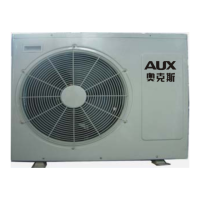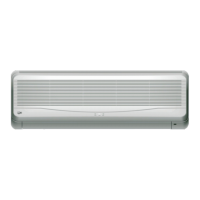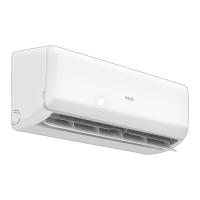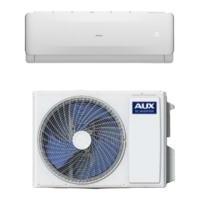AUX air conditioner service manual
187
a、Commute, demodulation, switch and stabilivolt diode. Remove diode from electrical panel, check its
single phase conductivity with R×1K and R×100 of universal meter. Check method: contact two ends
of diode with two handles of meter, record the resistance value, then change two handles with each
other and measure again. For a normal diode, two resistance values are different greatly; large one is
called reverse resistance and the smaller one forward resistance. Normally, forward resistance of
silicon diode is several hundreds or thousands ohm, and reverse resistance can be 1 1MΩ; for
germanium diode, forward resistances is 0~1000Ω, while reverse resistance over 100KΩ. If reverse
resistance is very low, this diode has been broken; if both reverse and forward resistances are ∞, diode
has broken; If difference between reverse and forward resistances is very slight or any of the two
resistances deviates greatly from normal value, this diode is defective and shall be replaced. However,
the said standard doesn’t apply to some special diodes, for example, high-voltage silicon stack,
(forward resistance of which is also very large, index finger only moves slightly even in the R×10K of
universal meter), and some stabilivolt tubes (reverse resistance around 20KΩ).
b、Light-emitting diode(LED). Except low voltage types, forward conductive voltage is larger than
1.8V, while most universal meters are of a voltage of 1.5V(except for R×10K), so they are unable to
make diode conduct, which cause reverse and forward resistances very large or even infinitely great.
To check LED, R×10K or universal meters with 9V or over voltage shall be used. When we use
R×10K of universal meter, LED can be checked in the same way as normal diode. No matter what
kind of diode, positive and negative poles can be judged. When you measure reverse resistance, the
end touched by red handle is positive pole, the other end is negative pole.
② Performance check for common triode
Main parameters to be measured are Iceo and h
FE
. In general, actual-measured resistance of
germanium triode with middle-small power shall be over 10~20KΩ; resistance of silicon triode shall
be over 100KΩ, and actually-measured value is infinitely great, i.e. index finger doesn’t swing. If
actual resistance is excess slight, it shows that Iceo is very large, and this kind of triodes can not be
used for their poor capacity. If actual resistance nears zero, c and e poles triode has broken down.
ICBO can also be measured in the same way: touch two handles of universal meter on b and c poles to
measure reverse resistance between them. Normally, resistance of germanium triode is larger than that
we obtain when we measure Iceo, and resistance of silicon triode is infinite great.
Based on the situation of measuring I
ceo,
another 100KΩ resistance(silicon triode) or 20KΩ
resistance(germanium) shall be connected to b and c poles. The more value indicated by index finger
becomes small, and the more h
FE
is large; if resistance doesn’t change much or changes slightly, triode
is broken or its enlargement capacity is very poor. Also, you can touch b and c with wet hands, but
avoiding direct touch of b and c, to measure the resistance. In addition, most universal meters
produced in recent years have position to measure h
FE
of small power triode. Operation method: turn
resistance position to 0Ω, and then turn to h
FE
position
;
Insert handles to related test hole, and read the
enlargement coefficient from h
FE
rule directly.
5. Cases of Maintenance of Electrical Control System
Case 1 Silicon Control is broken and indoor unit creates noise
Product Model:ASW-H07B4/HA
Phenomena:When unit is switched off, indoor fan runs slowly, and when it is turned on, unpleasant

